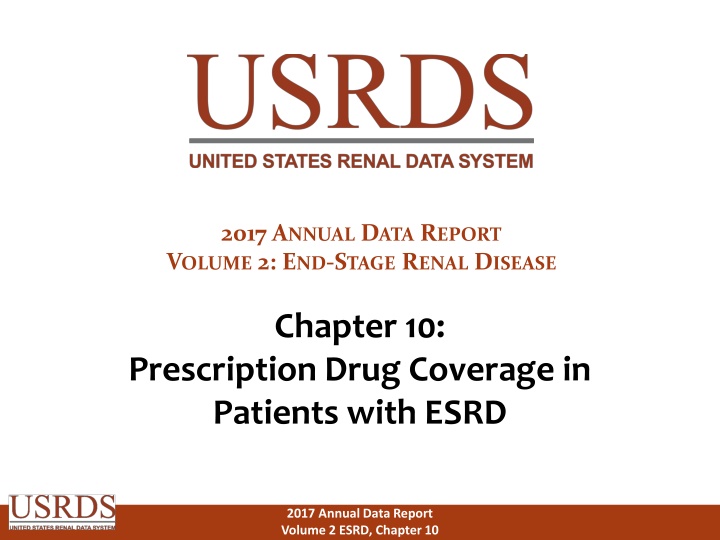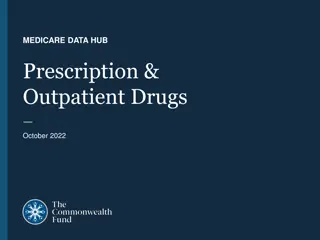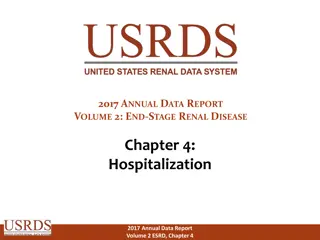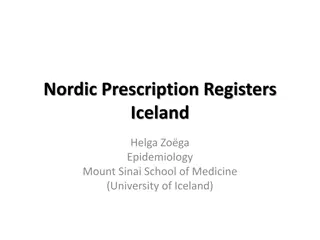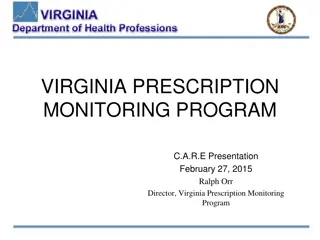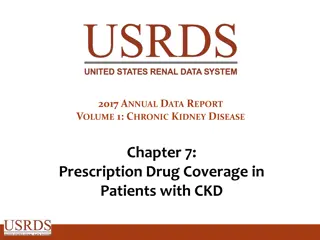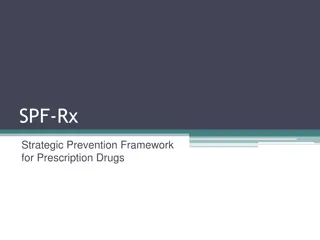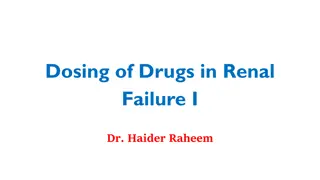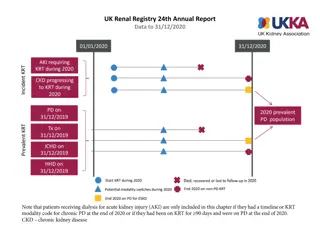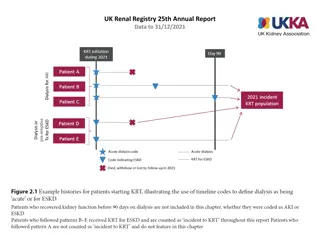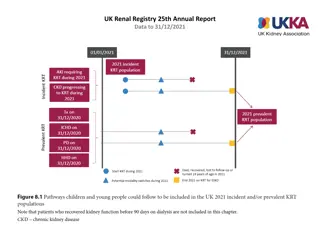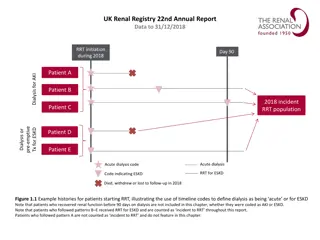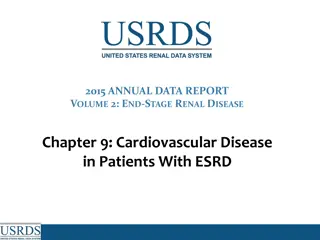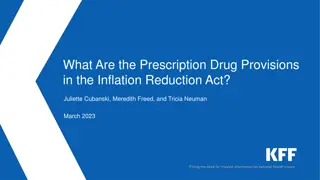Prescription Drug Coverage in Patients with End-Stage Renal Disease
Sources of prescription drug coverage in Medicare ESRD enrollees, percentage of patients enrolled in Part D, and Medicare Part D parameters for standard benefits.
Download Presentation

Please find below an Image/Link to download the presentation.
The content on the website is provided AS IS for your information and personal use only. It may not be sold, licensed, or shared on other websites without obtaining consent from the author.If you encounter any issues during the download, it is possible that the publisher has removed the file from their server.
You are allowed to download the files provided on this website for personal or commercial use, subject to the condition that they are used lawfully. All files are the property of their respective owners.
The content on the website is provided AS IS for your information and personal use only. It may not be sold, licensed, or shared on other websites without obtaining consent from the author.
E N D
Presentation Transcript
2017 ANNUAL DATA REPORT VOLUME 2: END-STAGE RENAL DISEASE Chapter 10: Prescription Drug Coverage in Patients with ESRD 2017 Annual Data Report Volume 2 ESRD, Chapter 10
vol 2 Figure 10.1 Sources of prescription drug coverage in Medicare ESRD enrollees, by population, 2015 Data source: 2015 Medicare Data, point prevalent Medicare enrollees alive on January 1, 2015. Abbreviations: ESRD, end-stage renal disease; HD, hemodialysis; LIS, Low-income Subsidy; Part D, Medicare Part D prescription drug coverage; PD, peritoneal dialysis; Tx, kidney transplant. 2017 Annual Data Report Volume 2, Chapter 10 2
vol 2 Table 10.1 Percentage of general Medicare & ESRD patients enrolled in Part D General Medicare (%) 60.1 61.8 67.2 69.1 70.4 Hemodialysis (%) 73.3 75.2 78.9 79.9 80.7 Peritoneal dialysis (%) 61.2 63.5 67.2 68.7 69.3 Transplant (%) 59.0 61.4 66.0 68.2 69.7 All ESRD (%) 69.4 71.3 75.2 76.5 77.4 2011 2012 2013 2014 2015 Data source: 2011-2015 Medicare data, point prevalent Medicare enrollees alive on January 1. Medicare data: general Medicare, 5% Medicare sample (ESRD, hemodialysis, peritoneal dialysis, and transplant, 100% ESRD population). Abbreviations: ESRD, end- stage renal disease; Part D, Medicare Part D prescription drug coverage. 2017 Annual Data Report Volume 2, Chapter 10 3
vol 2 Table 10.2 Medicare Part D parameters for defined standard benefit, 2010 & 2015 2010 2015 Deductible $310 $320 After the deductible is met, the beneficiary pays 25% of total prescription costs up to the initial coverage limit. Initial coverage limit The coverage gap ( donut hole ) begins at this point. The beneficiary pays 100% of their prescription costs up to the out-of-pocket threshold Out-of-pocket threshold $2,830 $2,960 $4,550 $4,700 The total out-of-pocket costs including the donut hole Total covered Part D prescription out-of-pocket spending Catastrophic coverage begins after this point (including the coverage gap). Catastrophic coverage benefit Generic/preferred multi-source drug $6,440.00 $6,680.00 $2.50 $6.30 *$2.65 *$6.60 plus a 55% brand-name medication discount Other drugs 2015 Example: $320 (deductible) $310.00 $320 +(($2960-$320)*25%) (initial coverage) $630.00 $660.00 +(($6680-$2960)*100%) (coverage gap) $3,610.00 $3,720.00 Total $4,550.00 $4,700.00 (maximum out-of-pocket costs prior to catastrophic coverage, excluding plan premium) *The catastrophic coverage amount is the greater of 5% of medication cost or the values shown in the chart above. In 2015, beneficiaries were charged $2.65 for those generic or preferred multisource drugs with a retail price less than $53 and 5% for those with a retail price over $53. For brand name drugs, beneficiaries paid $6.6 for those drugs with a retail price less than $132 and 5% for those with a retail price over $132. Table adapted from http://www.q1medicare.com/PartD-The-2015-Medicare-Part-D-Outlook.php. 2017 Annual Data Report Volume 2, Chapter 10 4
vol 2Figure 10.2 Sources of prescription drug coverage in Medicare ESRD enrollees, by age & modality, 2015 (a) Dialysis patients Data source: 2015 Medicare Data, point prevalent Medicare enrollees alive on January 1, 2015. Abbreviations: ESRD, end-stage renal disease; LIS, Low-income Subsidy; Part D, Medicare Part D prescription drug coverage. ESRD patients aged under 20 were not presented. 2017 Annual Data Report Volume 2, Chapter 10 5
vol 2Figure 10.2 Sources of prescription drug coverage in Medicare ESRD enrollees, by age & modality, 2015 (b) Transplant patients Data source: 2015 Medicare Data, point prevalent Medicare enrollees alive on January 1, 2015. Abbreviations: ESRD, end-stage renal disease; LIS, Low-income Subsidy; Part D, Medicare Part D prescription drug coverage. ESRD patients aged under 20 were not presented. 2017 Annual Data Report Volume 2, Chapter 10 6
vol 2 Figure 10.3 Sources of prescription drug coverage in Medicare ESRD enrollees, by race/ethnicity & modality, 2015 (a) Dialysis patients Data source: 2015 Medicare Data, point prevalent Medicare enrollees alive on January 1, 2015. Abbreviations: Blk/Af Am, Black or African American; ESRD, end-stage renal disease; LIS, Low-income Subsidy; Part D, Medicare Part D prescription drug coverage. 2017 Annual Data Report Volume 2, Chapter 10 7
vol 2 Figure 10.3 Sources of prescription drug coverage in Medicare ESRD enrollees, by race/ethnicity & modality, 2015 (b) Transplant patients Data source: 2015 Medicare Data, point prevalent Medicare enrollees alive on January 1, 2015. Abbreviations: Blk/Af Am, Black or African American; ESRD, end-stage renal disease; LIS, Low-income Subsidy; Part D, Medicare Part D prescription drug coverage. 2017 Annual Data Report Volume 2, Chapter 10 8
vol 2 Table 10.3 Percentage of Medicare Part D enrollees with the Low-income Subsidy, by age & race, 2015 General Medicare (%) All ESRD (%) Hemodialysis (%) Peritoneal dialysis (%) Transplant (%) White All ages 20-44 45-64 65-74 75+ Black/African American All ages 20-44 45-64 65-74 75+ Native American/Alaska Native All ages 20-44 45-64 65-74 75+ Asian All ages 20-44 45-64 65-74 75+ Hawaiian Native/Pacific Islander All ages 20-44 45-64 65-74 75+ Other/multiple race All ages 20-44 45-64 65-74 75+ Unknown/missing All ages 20-44 45-64 65-74 75+ 24.2 88.2 52.0 14.5 18.4 53.6 87.5 70.1 39.1 33.5 58.2 90.7 75.9 48.0 37.1 46.8 87.5 63.6 24.3 17.5 45.1 81.9 57.1 20.9 18.0 57.2 92.8 74.8 41.6 48.5 73.6 92.2 80.3 58.5 58.6 75.6 93.8 82.7 62.8 60.5 69.0 89.3 73.3 40.2 35.1 64.4 87.5 69.8 39.2 38.9 68.0 92.7 82.2 55.4 56.7 84.4 93.1 88.2 75.8 75.1 87.7 94.7 90.5 81.6 80.3 80.5 92.4 80.8 63.8 54.5 72.6 85.0 81.6 55.5 54.7 62.9 90.5 65.0 53.7 70.7 66.8 86.4 71.8 56.9 65.8 72.0 89.4 77.3 64.7 70.0 54.3 83.6 55.5 40.1 50.4 57.2 83.1 65.4 43.7 41.5 n/a n/a n/a n/a n/a 70.2 88.4 76.8 57.3 62.1 73.6 89.3 80.5 62.0 65.3 60.1 87.5 61.7 40.2 56.3 57.5 85.1 64.4 44.4 29.4 30.5 85.5 45.1 21.1 33.8 61.2 81.4 67.4 47.5 45.7 72.4 88.7 82.4 59.5 56.3 69.7 83.3 88.9 33.3 25.0 51.6 75.0 53.8 39.9 32.8 28.8 90.5 26.6 18.9 79.8 87.4 93.8 88.3 74.8 85.0 93.8 97.6 94.6 86.8 83.3 88.0 91.7 100.0 60.0 . 84.1 98.4 78.5 70.8 90.0 Data source: 2015 Medicare data, point prevalent Medicare enrollees alive on January 1, 2015. Abbreviations: ESRD, end-stage renal disease; LIS, Low-income Subsidy; Part D, Medicare Part D prescription drug coverage. ESRD patients aged under 20 were not presented 2017 Annual Data Report Volume 2, Chapter 10 9
vol 2 Figure 10.4 Distribution of Low-income Subsidy categories in Part D general Medicare & ESRD patients, 2015 Data source: 2015 Medicare data, point prevalent Medicare enrollees alive on January 1, 2015. Abbreviations: ESRD, end-stage renal disease; Part D, Medicare Part D prescription drug coverage. 2017 Annual Data Report Volume 2, Chapter 10 10
vol 2 Table 10.4 Total estimated Medicare Part D spending for enrollees, in billions, 2011-2015 General Medicare ($) 46.0 40.1 52.1 58.1 63.4 All ESRD ($) 1.8 2.0 2.3 2.7 3.2 Hemodialysis ($) 1.4 1.6 1.8 2.1 2.5 Peritoneal Dialysis ($) Transplant ($) 0.1 0.1 0.1 0.2 0.2 2011 2012 2013 2014 2015 0.2 0.3 0.3 0.4 0.5 Data source: 2011-2015 Medicare data, period prevalent Medicare enrollees alive on January 1, excluding those in Medicare Advantage Part D plans and Medicare secondary payer, using as-treated actuarial model (see ESRD Methods chapter for analytical methods). Part D spending represents the sum of the Medicare covered amount and the Low-income Subsidy amount. 2017 Annual Data Report Volume 2, Chapter 10 11
vol 2 Figure 10.5 Per person per year insurance & out-of- pocket costs for enrollees, 2015 (a) Medicare Data source: Medicare Part D claims and Optum Clinformatics Medicare (Parts A & B)., Costs are per person per year for calendar year 2015, using as-treated actuarial model (see ESRD Methods chapter for analytical methods). Part D spending represents the sum of the Medicare covered amount and the Low-income Subsidy amount. claims. Medicare totals include Part D claims for Part D enrollees with traditional 2017 Annual Data Report Volume 2, Chapter 10 12
vol 2 Figure 10.5 Per person per year insurance & out-of- pocket costs for enrollees, 2015 (b) Medicare Advantage Data source: Medicare Part D claims and Optum Clinformatics Medicare (Parts A & B)., Costs are per person per year for calendar year 2015, using as-treated actuarial model (see ESRD Methods chapter for analytical methods). Part D spending represents the sum of the Medicare covered amount and the Low-income Subsidy amount. claims. Medicare totals include Part D claims for Part D enrollees with traditional 2017 Annual Data Report Volume 2, Chapter 10 13
vol 2 Figure 10.5 Per person per year insurance & out-of- pocket costs for enrollees, 2015 (c) Managed Care Data source: Medicare Part D claims and Optum Clinformatics Medicare (Parts A & B)., Costs are per person per year for calendar year 2015, using as-treated actuarial model (see ESRD Methods chapter for analytical methods). Part D spending represents the sum of the Medicare covered amount and the Low-income Subsidy amount. claims. Medicare totals include Part D claims for Part D enrollees with traditional 2017 Annual Data Report Volume 2, Chapter 10 14
vol 2 Figure 10.5 Per person per year insurance & out-of- pocket costs for enrollees, 2015 (d) Medicare by Low-income Subsidy status Data source: Medicare Part D claims and Optum Clinformatics Medicare (Parts A & B)., Costs are per person per year for calendar year 2015, using as-treated actuarial model (see ESRD Methods chapter for analytical methods). Part D spending represents the sum of the Medicare covered amount and the Low-income Subsidy amount. claims. Medicare totals include Part D claims for Part D enrollees with traditional 2017 Annual Data Report Volume 2, Chapter 10 15
vol 2 Table 10.5 Per person per year insurance spending for enrollees, 2015 (continued) (a) Medicare All ESRD ($) Part D with LIS General ($) Hemodialysis ($) Part D with LIS Peritoneal dialysis ($) Part D with LIS Transplant ($) Part D with LIS Part D with LIS Part D without LIS Part D without LIS Part D without LIS Part D without LIS Part D without LIS Age All 20-44 45-64 65-74 75+ Sex Male Female Race White Black/African American Native American/Alaska Native Asian Native Hawaiian/Pacific-Islander Other race Unknown/missing 5,877 5,839 7,909 4,965 4,208 1,600 2,510 2,934 1,514 1,461 14,364 14,574 15,623 12,993 10,601 4,812 4,670 5,675 4,947 3,819 15,263 16,584 16,549 13,605 11,179 5,146 5,994 5,944 5,472 4,077 15,791 16,000 16,321 13,572 10,647 5,311 5,091 5,720 5,640 4,277 10,995 9,433 12,027 10,645 7,435 4,006 3,027 4,856 3,928 2,882 6,028 5,771 1,756 1,484 14,689 13,997 4,955 4,596 15,551 14,945 5,138 5,159 16,636 15,030 5,317 5,302 11,615 10,172 4,411 3,384 6,029 6,090 4,774 4,637 1,586 1,873 2,605 1,268 13,941 15,068 9,218 14,511 14,898 12,478 13,829 4,732 5,061 4,533 5,031 4,085 4,856 3,347 15,107 15,612 9,204 15,575 15,685 14,175 15,155 5,167 5,082 5,185 5,622 3,929 6,161 3,870 16,183 15,053 11,767 16,953 17,203 12,446 20,957 5,343 5,119 4,355 5,640 4,875 4,726 33,966 10,351 12,463 8,438 10,895 9,126 10,868 10,907 3,813 4,931 3,607 4,144 4,053 4,397 4,149 NA 4,973 4,723 NA 1,599 1,534 Data source: Medicare Part D claims and Optum Clinformatics claims. Costs are per person per year for calendar year 2015, using as- treated actuarial model (see ESRD Methods chapter for analytical methods). Part D spending represents the sum of the Medicare covered amount and the Low-income Subsidy amount. 2017 Annual Data Report Volume 2, Chapter 10 16
vol 2 Table 10.5 Per person per year insurance spending for enrollees, 2015 (continued) (b) Medicare Advantage General ($) All ESRD ($) All Dialysis ($) Transplant ($) Age All 20-44 45-64 65-74 75+ Sex Male Female Race White Black/African American Asian Unknown 1,836 4,849 4,928 1,563 1,421 6,139 14,168 10,035 5,893 4,125 5,596 10,725 9,228 5,619 4,050 9,181 20,641 12,295 7,093 5,387 1,836 1,836 5,932 6,376 5,186 6,057 9,915 8,265 1,855 2,678 1,842 1,689 5,738 7,477 7,805 5,590 5,249 6,701 7,176 5,321 8,305 13,897 11,468 6,756 Data source: Medicare Part D claims and Optum Clinformatics year 2015, using as-treated actuarial model (see ESRD Methods chapter for analytical methods). Part D spending represents the sum of the Medicare covered amount and the Low-income Subsidy amount. claims. Costs are per person per year for calendar 2017 Annual Data Report Volume 2, Chapter 10 17
vol 2 Table 10.5 Per person per year insurance spending for enrollees, 2015 (c) Managed care General ($) All ESRD ($) All Dialysis ($) Transplant ($) Age All 20-44 45-64 65-74 75+ Sex Male Female Race White Black/African American Asian Unknown 744 504 1,233 2,018 2,711 8,790 7,434 9,173 8,686 5,792 7,794 6,665 8,384 7,892 5,466 10,199 8,135 10,310 10,609 8,616 738 749 9,147 8,260 8,206 7,148 10,540 9,718 773 693 413 764 9,093 7,871 8,009 8,909 8,191 6,890 7,701 7,051 10,178 11,141 8,395 10,592 Data source: Medicare Part D claims and Optum Clinformatics year 2015, using as-treated actuarial model (see ESRD Methods chapter for analytical methods). Part D spending represents the sum of the Medicare covered amount and the Low-income Subsidy amount. claims. Costs are per person per year for calendar 2017 Annual Data Report Volume 2, Chapter 10 18
vol 2 Table 10.6 Top 15 drug classes received by ESRD cohorts in different health plans, by modality, 2015 (continued) Hemodialysis Peritoneal Dialysis Transplant Rank 1 Drug class % Drug class % Drug class % Ion-removing agents 71.2 Ion-removing agents 61.7 Antibacterials 74.3 2 -adrenergic blocking agents 63.7 -adrenergic blocking agents 60.3 -Adrenergic blocking agents 63.0 3 Antibacterials 58.7 Antibacterials 58.6 Antiulcer agents and acid suppressants 47.5 Lipid-lowering agents 59.6 4 Analgesics and antipyretics 58.4 Analgesics and antipyretics 56.6 5 Lipid-lowering agents 49.6 Lipid-lowering agents 47.3 Calcium-channel blocking agents 46.3 Analgesics and antipyretics 50.3 6 Calcium-channel blocking agents Antiulcer agents and acid suppressants Renin-angiotensin- aldosterone system inhibitors Antidiabetic agents 47.7 Calcium-channel blocking agents 46.9 Renin-angiotensin- aldosterone system inhibitors 38.5 Antiulcer agents and acid suppressants 37.1 Antidiabetic agents 49.2 7 42.8 Adrenals 47.0 (a) Medicare 8 39.7 Antidiabetic agents 39.1 9 33.5 Renin-angiotensin- aldosterone system inhibitors 33.5 Diuretics 36.3 10 Hypotensive agents 32.5 Anti-infectives 33.5 11 Psychotherapeutic agents 31.7 Diuretics 32.7 Psychotherapeutic agents 25.3 12 Anticonvulsants 31.4 Hypotensive agents 27.2 Antivirals 24.8 13 Cinacalcet 30.9 Psychotherapeutic agents 27.2 Diabetic consumables 24.6 14 Antithrombotic agents 30.2 Cinacalcet 25.6 Anticonvulsants 22.3 15 Anxiolytics, sedatives, and hypnotics 26.8 Replacement preparations 25.1 Anti-infectives 20.4 Data source: Medicare Part D claims and Optum Clinformatics claims. Ion-removing agents include phosphate-binding agents, potassium-binding agents, etc. Hypotension agents include alpha-2-agonist and vasodilators. Diabetic consumables refer to blood glucose test strips, blood glucose meters/sensors, lancets, needles, pen needles, etc. 2017 Annual Data Report Volume 2, Chapter 10 19
vol 2 Table 10.6 Top 15 drug classes received by ESRD cohorts in different health plans, by modality, 2015 (continued) (b) Medicare Advantage Dialysis Transplant Drug class Rank 1 2 3 4 5 6 7 8 9 Drug class % % -adrenergic blocking agents Lipid-lowering agents Analgesics and antipyretics Antibacterials Ion-removing agents Calcium-channel Blocking agents Antiulcer agents and acid suppressants Antidiabetic agents 44.8 Immunosuppressive agents 41.0 Antibacterials 40.4 Adrenals 40.2 -adrenergic blocking agents 37.2 Lipid-lowering agents 35.2 Antiulcer agents and acid suppressants 31.5 Calcium-channel Blocking agents 29.1 Analgesics and antipyretics Renin-angiotensin-aldosterone system inhibitors 48.0 40.9 38.8 35.5 34.8 29.4 28.0 27.8 Diuretics 26.8 25.1 10 Renin-angiotensin-aldosterone system inhibitors Diabetic consumables Antithrombotic agents Hypotensive agents Psychotherapeutic agents Anticonvulsants 26.7 Antidiabetic agents 24.4 11 12 13 14 15 24.8 Diabetic consumables 22.5 Diuretics 22.0 Psychotherapeutic agents 21.9 Antithrombotic agents 20.1 Anticonvulsants 23.3 20.2 15.6 14.5 13.9 Data source: Medicare Part D claims and Optum Clinformatics claims. Ion-removing agents include phosphate-binding agents, potassium- binding agents, etc. Hypotension agents include alpha-2-agonist and vasodilators. Diabetic consumables refer to blood glucose test strips, blood glucose meters/sensors, lancets, needles, pen needles, etc. 2017 Annual Data Report Volume 2, Chapter 10 20
vol 2 Table 10.6 Top 15 drug classes received by ESRD cohorts in different health plans, by modality, 2015 (c) Managed Care Dialysis Transplant Drug class Rank Drug class % % 1 2 3 4 5 6 7 Ion-removing agents -adrenergic blocking agents Analgesics and antipyretics Antibacterials Calcium-channel Blocking agents Lipid-lowering agents Renin-angiotensin-aldosterone system inhibitors Antidiabetic agents Diuretics Hypotensive agents Vitamin D Antiulcer agents and acid suppressants Diabetic consumables Antithrombotic agents Anxiolytics, sedatives, and hypnotics 44.0 Immunosuppressive agents 42.6 Antibacterials 37.8 Adrenals 36.6 -adrenergic blocking agents 35.7 Lipid-lowering agents 31.3 Calcium-channel Blocking agents Renin-angiotensin-aldosterone system inhibitors 24.3 Analgesics and antipyretics 24.0 Antiulcer agents and acid suppressants 22.9 Antidiabetic agents 20.0 Diuretics 19.7 Vitamin D 18.9 Diabetic consumables 14.9 Anxiolytics, sedatives, and hypnotics 14.5 Psychotherapeutic agents 52.8 43.8 39.3 32.0 30.2 26.0 28.5 25.8 8 9 10 11 12 13 14 15 25.6 20.6 15.3 14.3 13.1 13.0 11.9 11.7 Data source: Medicare Part D claims and Optum Clinformatics claims. Ion-removing agents include phosphate-binding agents, potassium- binding agents, etc. Hypotension agents include alpha-2-agonist and vasodilators. Diabetic consumables refer to blood glucose test strips, blood glucose meters/sensors, lancets, needles, pen needles, etc. 2017 Annual Data Report Volume 2, Chapter 10 21
vol 2 Table 10.7 Top 15 drug classes received by different ESRD cohorts, by modality and insurance spending, 2015 (continued) (a) Medicare Hemodialysis Peritoneal Dialysis Transplant Costs Costs Costs Rank 1 Drug class % Drug class % Drug class % Ion-removing agents $1,005.1 40.7 Ion-removing agents $83.3 41.7 Antivirals $152.0 33.4 Cinacalcet $546.0 22.1 Cinacalcet $41.8 20.9 Antidiabetic agents $76.2 16.8 2 Antidiabetic agents $192.0 7.8 Antidiabetic agents $20.2 10.1 Cinacalcet $40.3 8.9 3 Antivirals $135.3 5.5 Antivirals $11.1 5.5 Immunosuppressive agents $21.8 4.8 4 Antineoplastic agents $57.8 2.3 Antineoplastic agents $4.4 2.2 Antiulcer agents and acid suppressants Lipid-lowering agents $11.9 2.6 5 Antiulcer agents and acid suppressants Analgesics and antipyretics $35.1 1.4 Lipid-lowering agents $3.0 1.5 $11.8 2.6 6 $32.2 1.3 Antiulcer agents and acid suppressants Antibacterials $2.4 1.2 Adrenocortical Insufficiency $8.5 1.9 7 Lipid-lowering agents $31.9 1.3 $2.1 1.1 Antibacterials $7.7 1.7 8 Psychotherapeutic agents $26.6 1.1 Analgesics and antipyretics $1.6 0.8 Hematopoietic agents $7.4 1.6 9 Vasodilating agents $26.4 1.1 Serums $1.5 0.8 Antineoplastic agents $7.0 1.5 10 Antibacterials $26.3 1.1 Pituitary $1.5 0.8 Psychotherapeutic agents $7.0 1.5 11 Anticonvulsants $25.2 1.0 Vasodilating agents $1.4 0.7 Serums $6.4 1.4 12 Caloric agents $23.7 1.0 Anticonvulsants $1.4 0.7 Anticonvulsants $6.2 1.4 13 Anti-inflammatory agents $20.5 0.8 Psychotherapeutic agents $1.3 0.6 Analgesics and antipyretics $5.8 1.3 14 Antithrombotic agents $15.2 0.6 -adrenergic blocking agents $1.1 0.6 Antithrombotic agents $4.7 1.0 15 Data source: Medicare Part D claims and Optum Clinformatics and the Low-income Subsidy amount. Ion-removing agents include phosphate-binding agents, potassium-binding agents, etc. Hypotension agents include alpha-2-agonists and vasodilators. Diabetic consumables refer to blood glucose test strips, blood glucose meters/sensors, lancets, needles, pen needles, etc. claims. Part D spending represents the sum of the Medicare covered amount 2017 Annual Data Report Volume 2, Chapter 10 22
vol 2 Table 10.7 Top 15 drug classes received by different ESRD cohorts, by modality and insurance spending, 2015 (continued) (b) Medicare Advantage Dialysis Transplant Costs Costs Rank 1 2 3 4 5 6 7 8 9 Drug class % Drug class % Ion-removing agents Cinacalcet Antidiabetic agents Antineoplastic agents Diabetic consumables Antivirals Lipid-lowering agents Vasodilating agents Analgesics and antipyretics $13.9 $7.3 $5.2 $2.2 $1.9 $1.7 $1.6 $1.2 $1.0 27.4 14.3 10.3 4.3 3.7 3.4 3.2 2.3 1.9 Immunosuppressive agents Antivirals Antidiabetic agents Cinacalcet Diabetic consumables Ion-removing agents Lipid-lowering agents Antithrombotic agents Antiulcer agents and acid suppressants Antibacterials $5.2 $2.8 $1.3 $1.3 $0.5 $0.4 $0.3 $0.2 $0.2 34.8 19.0 8.8 8.4 3.5 2.8 2.2 1.3 1.3 10 Antiulcer agents and acid suppressants Calcium-channel Blocking agents Psychotherapeutic agents Anti-inflammatory agents $0.8 1.6 $0.2 1.3 11 $0.7 1.5 Psychotherapeutic agents $0.2 1.1 12 13 $0.7 $0.7 1.5 1.4 Analgesics and antipyretics Calcium-channel Blocking agents Serums -adrenergic blocking agents $0.2 $0.1 1.0 0.9 14 15 Antibacterials Hypotensive agents $0.7 $0.7 1.4 1.4 $0.1 $0.1 0.9 0.8 Data source: Medicare Part D claims and Optum Clinformatics covered amount and the Low-income Subsidy amount. Ion-removing agents include phosphate-binding agents, potassium- binding agents, etc. Hypotension agents include alpha-2-agonists and vasodilators. Diabetic consumables refer to blood glucose test strips, blood glucose meters/sensors, lancets, needles, pen needles, etc. claims. Part D spending represents the sum of the Medicare 2017 Annual Data Report Volume 2, Chapter 10 23
vol 2 Table 10.7 Top 15 drug classes received by different ESRD cohorts, by modality and insurance spending, 2015 (c) Managed Care Costs Dialysis Transplant Costs Rank 1 2 3 4 5 6 7 8 9 10 11 Drug class % Drug class % Ion-removing agents Cinacalcet Antidiabetic agents Antineoplastic agents Antivirals Immunosuppressive agents Diabetic consumables Lipid-lowering agents Antibacterials Vasodilating agents Calcium-channel Blocking agents Hypotensive agents Hematopoietic agents $8.4 $3.2 $2.4 $1.2 $1.1 $0.7 $0.5 $0.5 $0.3 $0.3 $0.3 35.6 13.7 10.3 5.0 4.8 3.0 2.2 2.2 1.3 1.3 1.3 Immunosuppressive agents Antivirals Cinacalcet Antidiabetic agents Ion-removing agents Lipid-lowering agents Hematopoietic agents Antibacterials Diabetic consumables Antithrombotic agents Pituitary $9.4 $3.4 $1.5 $1.4 $1.0 $0.4 $0.4 $0.4 $0.3 $0.2 $0.2 43.2 15.9 6.7 6.4 4.4 2.1 1.8 1.6 1.6 1.0 1.0 12 13 $0.3 $0.3 1.2 1.1 -adrenergic blocking agents Calcium-channel Blocking agents Antifungals Psychotherapeutic agents $0.2 $0.2 0.8 0.7 14 15 Analgesics and antipyretics -adrenergic blocking agents $0.3 $0.3 1.1 1.1 $0.2 $0.2 0.7 0.7 Data source: Medicare Part D claims and Optum Clinformatics the Low-income Subsidy amount. Ion-removing agents include phosphate-binding agents, potassium-binding agents, etc. Hypotension agents include alpha-2-agonists and vasodilators. Diabetic consumables refer to blood glucose test strips, blood glucose meters/sensors, lancets, needles, pen needles, etc. claims. Part D spending represents the sum of the Medicare covered amount and 2017 Annual Data Report Volume 2, Chapter 10 24
vol 2 Figure 10.6 Estimated utilization rate of prescription NSAIDs by state, Medicare ESRD Patients, 2015 Data source: Medicare Part D claims. ESRD patients with Medicare Part D stand-alone prescription drug plans. Abbreviations: NSAIDs, nonsteroidal anti-inflammatory agents. NSAID filled under Medicare Part D represent a fraction of actual NSAID use. . 2017 Annual Data Report Volume 2, Chapter 10 25
vol 2 Figure 10.7 Estimated utilization rate of opioid analgesics by state, Medicare ESRD Patients, 2015 Data source: Medicare Part D claims. ESRD patients with Medicare Part D stand-alone prescription drug plans. 2017 Annual Data Report Volume 2, Chapter 10 26
